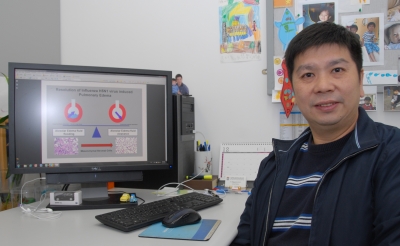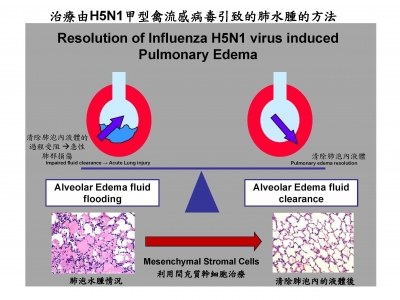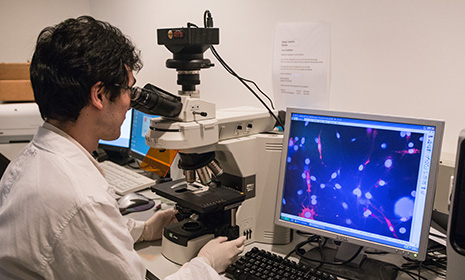HKU Reveals Novel Mechanisms by which H5N1 Influenza Virus Causes Acute Lung Injury in Humans and Discovers Novel Therapeutic Strategies
*adapted from the contents published by the Li Ka Shing Faculty of Medicine, The University of Hong Kong at http://www.med.hku.hk/v1/archives/13670
H5N1 influenza causing severe lung disease in humans was first detected in Hong Kong in 1997, but to date, effective treatment remains elusive. Researchers from Li Ka Shing Faculty of Medicine, The University of Hong Kong (HKU) have recently discovered novel mechanisms by which avian influenza H5N1 virus causes acute lung injury and leads to severe pneumonia in humans through the impairment of sodium and chloride transporter molecules in the human lung epithelium. The research team further discovers novel therapeutic strategies for treating human H5N1 disease. These groundbreaking findings have just been published in Proceedings of National Academy of Sciences of the United States of America(PNAS), a top international journal which publishes articles with original scientific research of exceptional importance.
Avian Influenza H5N1
The first outbreak of the highly pathogenic avian influenza H5N1 virus in humans occurred in Hong Kong in 1997. Approximately 1.6 million poultry were culled by the government in 1997 in order to halt further human infections by avian influenza H5N1 virus. Avian influenza (such as H5N1, H7N9, H9N2) are influenza A viruses. It was known previously to infect birds only, but 18 human cases caused by the H5N1 strain were documented in Hong Kong in 1997 and another two were documented in Hong Kong in 2003. As of January 2016, there have been a total of 846 confirmed human influenza H5N1 cases leading to 449 deaths in the world.
Research findings and implications
Acute lung injury is a life-threatening complication of severe human influenza virus infection caused by avian (e.g. H5N1, H7N9) and other influenza viruses. The mechanism by which H5N1 virus causes acute lung injury remains unclear. In this study, a “test-tube model” has been developed to study the mechanism by which these viruses cause acute lung injury.
Dr Michael Chan Chi-wai, Assistant Professor of the School of Public Health, Li Ka Shing Faculty of Medicine, HKU, says, “Our study finds out that influenza viruses reduce the activity of sodium and chloride transporter molecules in the human lung epithelium, thus reducing the ability to clear fluid accumulating within the lung alveoli and leading to ‘flooding’ of the lung air-spaces. In this regard, H5N1 influenza virus had a much stronger adverse impact than seasonal influenza viruses, explaining why H5N1 virus causes more severe disease in humans.”
Professor Malik Peiris, Tam Wah-Ching Professor in Medical Science, Chair Professor of Virology and Director of School of Public Health, Li Ka Shing Faculty of Medicine, HKU, points out, “These findings suggest new approaches for treating patients with H5N1 disease that can be used to supplement conventional antiviral drugs. If we can restore the activity of these salt and water transporter molecules, we can minimise or prevent the severe lung injury caused by viruses like H5N1.” The study shows that the administration of human mesenchymal stromal cells (MSCs) can restore the activity of sodium and chloride transporters in the lungs of H5N1 virus infected mice, decrease lung injury and improve survival. Professor Malik Peiris adds, “This provides a novel and potent therapeutic strategy for treating human H5N1 disease. These findings may also be relevant to other viruses that may cause severe viral pneumonia by similar mechanisms, such as SARS and MERS coronaviruses and other avian influenza viruses such as H7N9 and H9N2.” “We may also be able to find simpler treatments that restore the activity of these transport molecules,” he added.
About the research team
This research has been conducted since 2014 and under the Centre of Influenza Research, School of Public Health, Li Ka Shing Faculty of Medicine, HKU. It was led by Dr Michael Chan Chi-wai, Assistant Professor of School of Public Health and Professor Malik Peiris, Tam Wah-Ching Professor in Medical Science, Chair Professor of Virology and Director of School of Public Health, Li Ka Shing Faculty of Medicine, HKU. Other research team members include Professor John Nicholls, Clinical Professor of the Department of Pathology and Professor Yi Guan, Daniel C K Yu Professor in Virology of the School of Public Health, Li Ka Shing Faculty of Medicine, HKU; Professor Robert Webster at St. Jude Children’s Research Hospital, Memphis, USA; and Professor Michael Matthay and Dr. Jae Lee of The University of California, San Francisco, USA.

Researchers who led the study, Dr Michael Chan Chi-wai (Left), Assistant Professor of School of Public Health and Professor Malik Peiris (Right), Tam Wah-Ching Professor in Medical Science, Chair Professor of Virology and Director of School of Public Health, Li Ka Shing Faculty of Medicine, HKU.

Dr Michael Chan Chi-wai, Assistant Professor of the School of Public Health, Li Ka Shing Faculty of Medicine, HKU points out that influenza viruses reduce the activity of sodium and chloride transporter molecules in the human lung epithelium, and therefore reduce the ability to clear fluid accumulating within the lung alveoli and lead to pulmonary edema and acute lung injury.

The photo shows that mesenchymal stromal cells can effectively clear the fluid accumulating within the lung alveoli.








.png)
